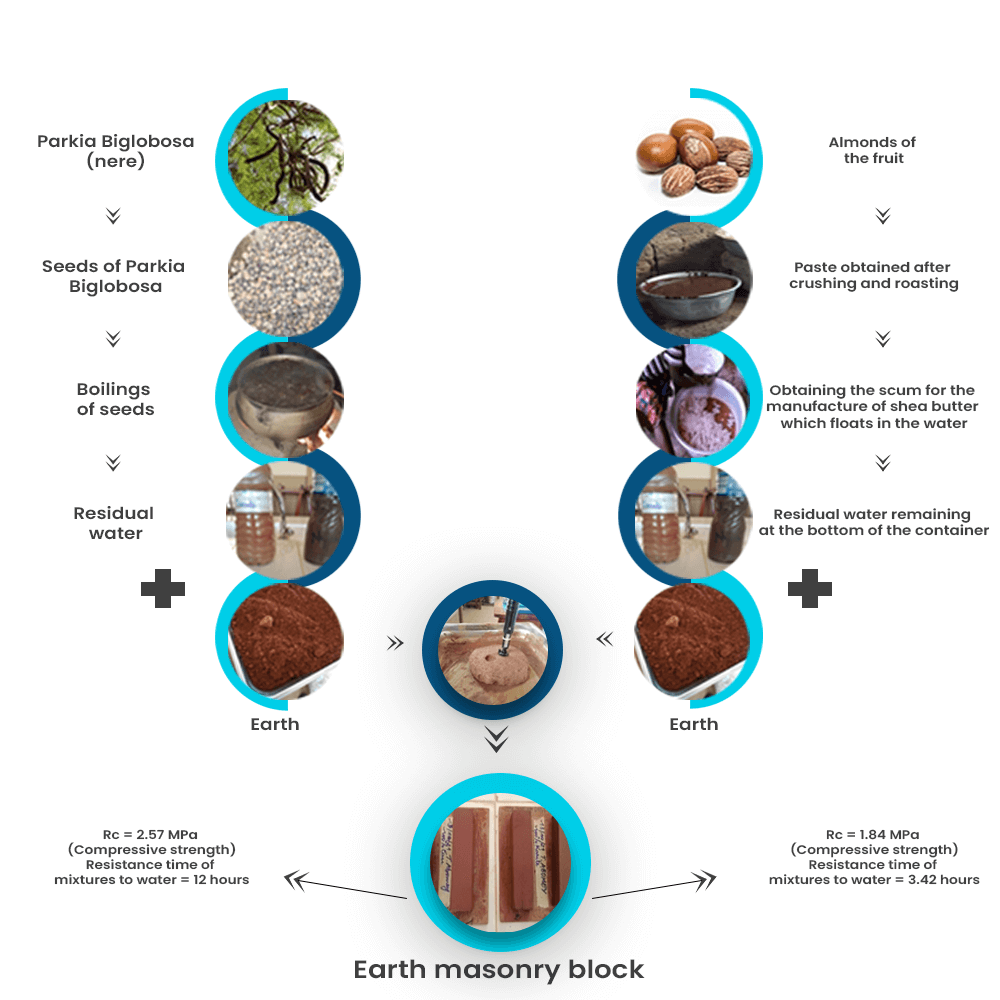 Open Access
Open Access
ARTICLE
Use of Additive Based on Non-Timber Forest Products for the Ecological Stabilization of Raw Earth: Case of the Parkia Biglobosa Nut and Vitellaria Paradoxa
1
L2EGC-Laboratory of Studies and Tests in Civil Engineering, University of Sciences, Technology, Engineering, and Mathematics,
Abomey, Benin
2
IJL-Jean Lamour Institute, University of Lorraine, Nancy, France
3
LEMA-Laboratory of Energetics and Applied Mechanics, University of Abomey-Calavi, Abomey-Calavi, Benin
4
LERMAB-Study and Research Laboratory on Wood Material, University of Lorraine, Nancy, France
* Corresponding Author: Crespin Prudence Yabi. Email:
Journal of Renewable Materials 2023, 11(12), 4143-4160. https://doi.org/10.32604/jrm.2023.030509
Received 10 April 2023; Accepted 29 June 2023; Issue published 10 November 2023
Abstract
The housing sector today uses elaborate materials such as cement, iron, sand, often prohibitively expensive and whose production generates a strong environmental impact (scarcity of resources, transport, greenhouse gas greenhouse, etc.). In order to meet the challenges of sustainable development, earth construction is experiencing a resurgence of interest these days. Despite its many advantages, raw earth material has drawbacks, in particular its low mechanical resistance and its loss of geometric characteristics in the face of water, which slow down its development. As part of this study, the mechanical characteristics and durability of raw earth were improved by using residual water from the processing of Parkia Biglobosa (nere) and Vitellaria Paradoxa (shea) nuts in order to optimize its use for the construction of modern buildings. To this end, the decoctions resulting from the artisanal transformation of the nut of the Parkia Biglobosa into African mustard and of the Vitellaria Paradoxa into shea butter were added to the raw earth according to volume proportions of 25%, 50%, 75% and 100% of the aqueous solution to obtain the projected composites. Thus, mechanical characterization and durability tests were carried out on the composites obtained. The results revealed that the decoctions of Vitellaria Paradoxa and Parkia Biglobosa improve the compressive strength of the material by up to 90% and 260%, respectively. Furthermore, these decoctions improved the resistance to water penetration of the 100% additive composite by 1.5 times for Vitellaria Paradoxa and 5 times for Parkia Biglobosa. This study shows that it is possible to use decoctions as raw earth stabilizers to build modern, ecological buildings at lower energy costs. However, more in-depth studies on surface wettability and long-term durability are planned to better characterize the geomaterial.Graphic Abstract

Keywords
Cite This Article
 Copyright © 2023 The Author(s). Published by Tech Science Press.
Copyright © 2023 The Author(s). Published by Tech Science Press.This work is licensed under a Creative Commons Attribution 4.0 International License , which permits unrestricted use, distribution, and reproduction in any medium, provided the original work is properly cited.


 Submit a Paper
Submit a Paper Propose a Special lssue
Propose a Special lssue View Full Text
View Full Text Download PDF
Download PDF Downloads
Downloads
 Citation Tools
Citation Tools